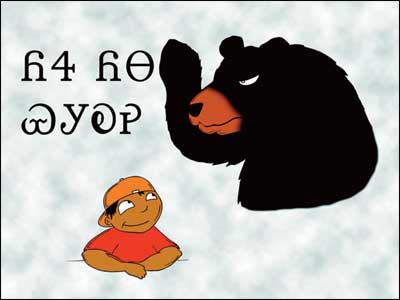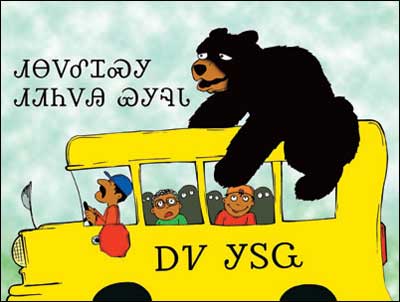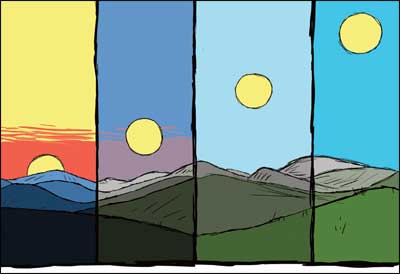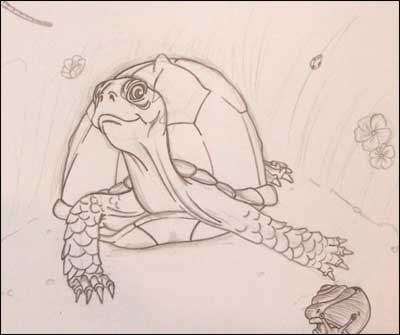 |
Canku Ota
|
 |
|
(Many Paths)
|
||
|
An Online Newsletter
Celebrating Native America
|
||
|
May 1, 2011 - Volume
9 Number 5
|
||
|
|
||
|
Preserving the
Cherokee Language with Children's Books
|
||
|
by Davin Eldridge —
Staff Writer Macon County News
|
||
|
By commissioning artists throughout the region to illustrate the children's books, KPEP hopes to keep the near-extinct language alive by catching the interest of Cherokee youth at an early age and introducing them to their native tongue. "Our language is kind of dying out, so this is the biggest and most important step we could take," said KPEP Electronic Media Coordinator Alexandro Cruz. The Kituwah academy is currently teaching the Cherokee language as a primary language to first grade children. There are now approximately 60 students in the language revitalization program.
Though the stories were wrought in ages past, each with its own moral, they are presented in a modern manner-visually reflecting current culture and technology. "A lot of people have the concept that we live in teepees and that kind of stuff, like that's how we are. That's a fictitious type of thing," said Cruz. "We want the kids to relate to the modern era. They aren't growing up as kids were 50 or 60 years ago," he said.
Among the illustrators are Amberly Rogers
and Tony Mingacci, both of Franklin. When the two artists are not
penciling pages for the books, they are inking the skin canvases
of their customers at Estelle Tattoo Parlor "It's a real honor that they chose me to help preserve their language for their children," said Rogers. "I get to take the stories they give me, bring them to life and make them exciting for children to see and learn from." Echoing Rogers' appreciation for KPEP's language preservation efforts, Mingacci remarked on the subtle teachings he has encountered in the book he is working on.
Without giving too much of the story away, Mingacci noted that it teaches children to be resourceful, to take care of others and the importance of responsibility. He chose to compose the art for the book with pencils and markers. The choice, as he described, rendered a sense of organic simplicity to the work. The book I am working on now is called ‘The Elder Turtle'," said Rogers. "It's about a turtle that walks around and observes nature. He is the oldest turtle and knows a lot of things, however he is going around and telling you why these things are important and why they're beautiful." The moral of the story, Rogers said, was to be grateful for nature. Unlike her counterpart who does all of his work by hand, Rogers drafts her works in pencil, then scans it digitally, and paints it in a photoshop program. "Doing this digitally allows me to achieve more vibrant colors," she said. "Because this story is about nature, and intended for younger children, I thought bright colors would work best."
The books will not only be distributed throughout the Cherokee Indian reservation, but they will also be distributed throughout North America, Cruz explained. "I feel like it means a lot to us for the main reason that we're creating and generating more reading material for the future of our Cherokee speakers and the survival of our Cherokee language," he concluded. "So it's a very important task that we must meet and excel in." There is still need for artists or other people with talent, said Cruz. For more information about the Language Immersion program of the Kituwah Preservation & Education Program, visit their website here. |
|
|
||
|
|
||
| Canku Ota is a free Newsletter celebrating Native America, its traditions and accomplishments . We do not provide subscriber or visitor names to anyone. Some articles presented in Canku Ota may contain copyright material. We have received appropriate permissions for republishing any articles. Material appearing here is distributed without profit or monetary gain to those who have expressed an interest. This is in accordance with Title 17 U.S.C. Section 107. | ||
|
Canku Ota is a copyright ©
2000, 2001, 2002, 2003, 2004, 2005, 2006, 2007, 2008, 2009, 2010,
2011 of Vicki Barry and Paul Barry.
|
||
 |
 |
|
|
The "Canku
Ota - A Newsletter Celebrating Native America" web site and
its design is the
|
||
|
Copyright ©
1999, 2000, 2001, 2002, 2003, 2004, 2005,
2006, 2007, 2008, 2009, 2010, 2011
of Paul C. Barry.
|
||
|
All Rights Reserved.
|
||
 The
Kituwah Preservation & Education Program [KPEP] is taking measures
to preserve the ancient language of the Eastern Band of Cherokee
Indians, with colorful children's books written in the native Cherokee
language and illustrated by local artists.
The
Kituwah Preservation & Education Program [KPEP] is taking measures
to preserve the ancient language of the Eastern Band of Cherokee
Indians, with colorful children's books written in the native Cherokee
language and illustrated by local artists.  To
help teach the young students the Cherokee language, KPEP members
concluded that it would be a good idea to publish children's books
with the native language bound within each page. Moreover, all of
the books contain traditional Cherokee stories handed down throughout
the generations. The length and the subject matter of the books
will grow along with the age of readers, said Cruz.
To
help teach the young students the Cherokee language, KPEP members
concluded that it would be a good idea to publish children's books
with the native language bound within each page. Moreover, all of
the books contain traditional Cherokee stories handed down throughout
the generations. The length and the subject matter of the books
will grow along with the age of readers, said Cruz. Depicting
the new, retelling the old
Depicting
the new, retelling the old "It's
called ‘The Beast'," said Mingacci, pointing to a draft of
one of his drawings of two young men attempting to subdue a snake.
"It's pretty much about these boys finding their bravery. They encounter
[the snake] and have to figure out how to get it away from them."
"It's
called ‘The Beast'," said Mingacci, pointing to a draft of
one of his drawings of two young men attempting to subdue a snake.
"It's pretty much about these boys finding their bravery. They encounter
[the snake] and have to figure out how to get it away from them." "So
far this has been really enjoyable," concluded Rogers, in sync with
Mingacci. "These stories have a lot of history— drawing it
for the new generation is definitely an honor." Both stories are
on the threshold of completion, Rogers said, at which point they
will begin work on another story. According to Cruz, once all art
for the books is submitted, it will take 6-8 weeks for the works
to be published.
"So
far this has been really enjoyable," concluded Rogers, in sync with
Mingacci. "These stories have a lot of history— drawing it
for the new generation is definitely an honor." Both stories are
on the threshold of completion, Rogers said, at which point they
will begin work on another story. According to Cruz, once all art
for the books is submitted, it will take 6-8 weeks for the works
to be published.